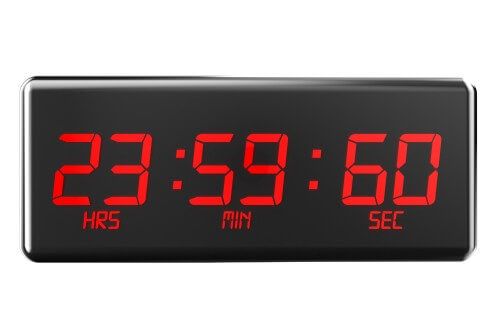Instead of midnight (00:00:00) Greenwich time it was 23:59:60 and this is to compensate for the random changes in the movement of the earth

The Earth's rotation is slowing slightly, so adding a second is a way to account for that, says Daniel McMillan of NASA's Goddard Flight Center in Maryland, in a press release from the agency.
"Everyone knows that the length of the day is 24 hours, or 86,400 seconds, but the time it takes for the earth to rotate around its axis until it reaches the same point relative to the sun - a solar day (or the length of the average day) is about 86,400.002 seconds. This happens because of the deceleration caused by the damping force created as a result of the 'struggle' between the Earth, the Sun and the Moon.
These planetary forces have meant that the day has not lasted exactly 86,400 seconds since 1820.
Two milliseconds a day doesn't sound like a significant amount of time, but in an annual calculation it comes to almost a second. However, the reality is more complicated. The Earth does slow down gradually but the length of specific days may change in unexpected ways. Among the factors that control the length of the day - daily and seasonal weather changes can affect the length of the day by several milliseconds a year, also tides in the sea and air and reefs in the atmosphere, the oceans, the internal water bodies and the amount of ice. Also a cyclical climatic phenomenon such as El Niño caused by the weakening of the trade winds in the Pacific Ocean, and their strengthening in the middle latitudes can slow down the rotation of the globe and add militias to the day.
Geological phenomena such as redistribution of mass and angular momentum in different parts of the earth may also affect the length of the day. According to Chopo what a geophysicist in Goddard. "When the mass or momentum is redistributed, the rate of rotation of the Earth can change like the rate of rotation of a roller skater can change if his arms are open to the sides.
The scientists record the length of the day every day using a method known as long baseline interferometry (VLBI. The scientists developed VLBI in the XNUMXs to observe quasars - bright centers of galaxies that have material falling into their black holes. However, the researchers realized that since the quasars barely move these bright objects can be used as reference points.
Now the VLBI, consisting of radio dishes deployed around the world, is used to determine the relative motion of the Earth compared to the quasars.
Universal Time #1 (UT1) is based on measurements of the Earth's rotation. Because this time is not constant, it occasionally drifts from Coordinated Universal Time (UTC) formerly Greenwich Mean Time, which is based on a precise atomic clock. The researchers want to keep UT1 and UTC at most 0.9 seconds apart, so they add a second when needed, usually on June 30 or December 31.
On a normal day, after 23:59:59 comes the next day's 00:00:00, but the last minute of June 30 Greenwich Mean Time had 61 seconds and therefore the clock moves from 23:59:59 to 23:59:60 before moving to the next day's zero hour.
This jump, which is usually not planned well in advance, can cause problems in computers, which can cause a data overflow that will disturb, for example, stock traders, programmers and airlines unless their systems are ready for the change.
The addition of the second in 2012 caused problems for companies such as Reddit, LinkedIn, Gizmodo and others.
The scientists added a second to each of the years 1972-2000 but since then the pace has slowed and today's replacement was only the fourth since 2000.
Because of this and because of the disruption to the computer systems, the World Communications Association is considering stopping the practice, or finding a technological solution to the computer synchronization problem. The issue will be discussed at the next meeting of the union in Geneva in November this year.
For a press release on the NASA website
More on the subject on the science website
The last minute of 2005 will last 61 seconds

4 תגובות
There is an error in the article.
2 milliseconds are 0.000002 so the length of a day is 86,400.000002
Moshe,
I understand what misled you, in the Hebrew article there is a wrong figure (which does not appear in the original) that talks about the time the earth orbits the sun. But the subject is the rotation of the earth on its axis.
Moshe: No.
It is about the rotation of the earth around itself, not the rotation around the sun.
If we slow down - then we are also supposed to get closer to the sun?